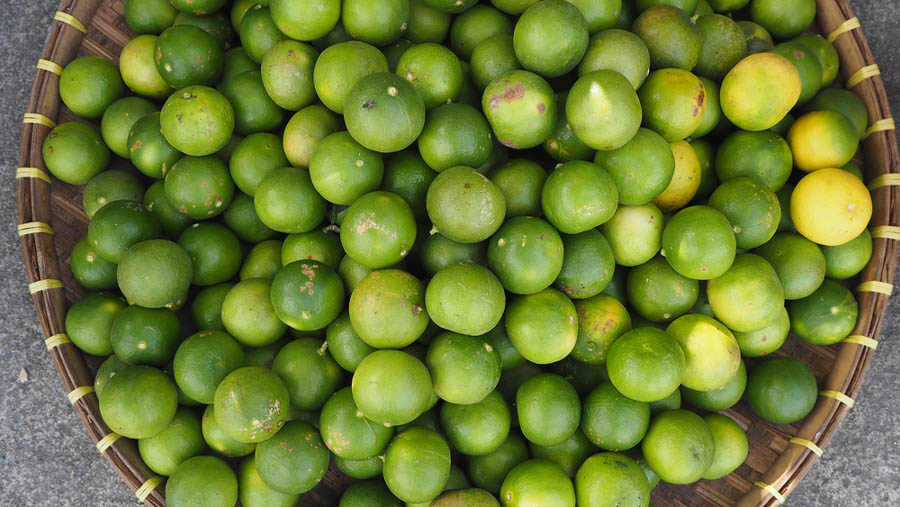Complex, Tart and Bitter: The GardenZeus Guide to Lime Tree Varieties

California’s Mediterranean climates are suitable for growing some but not all limes, as the needs of lime trees vary depending on the variety. In general, lime trees do best in areas where frosts are not common. It may be possible for lime trees to perform well in mild Mediterranean climates along the coast that are frost-free. Lime trees also perform well in inland Mediterranean climates without extreme temperatures, that is in Mediterranean climates that are both frost free and without excessive summer heat. In general, GardenZeus recommends Bearss limes for California gardeners who would like a reliable, productive lime tree in their yard. Gardeners who want to grow limes for use in southeast Asian cooking should consider the Kafir lime. The Australian Finger Lime is an excellent choice for gardeners who want to grow something different, a fruit with a true lime flavor and the texture of caviar.
True limes (Citrus aurantifolia), also known as Key Limes or Mexican limes and pictured above, are not generally recommended for growing in warm to hot inland areas, and have a somewhat limited range compared to other types of citrus. They cannot tolerate freezing temperatures, and start to incur frost damage at 32 degrees. In cooler areas they lose their leaves and have difficulty absorbing nutrients, resulting in weak, twiggy trees. The Key Lime can be successfully grown in California only if much attention is paid to temperature and care, as they require longer, warmer temperatures than all other types of citrus; they also like humidity. True limes are sought after for their complex flavor and aromatic properties. They are more tart than other limes, with bitter notes as well. They also have a very thin skin, and can be easily damaged if not harvested with care. Trees can be very thorny. Semi dwarf trees grow to 8-12 feet, dwarf trees to 3-4 feet. Leaves on a true lime tree are significantly smaller than on other types of lime trees.
For a reliable, productive lime tree in California, GardenZeus recommends Bearss limes (Citrus latifolia), also known as Persian or Tahitian limes. Like lemons, Bearss limes do not require high heat to mature, making them a better choice for growing in California than true limes. Compared to a true lime, the Bearss lime is larger, has slightly rougher skin, and stores better. It has a less acidic, more mild flavor than a true lime. Fully ripe fruit turn pale yellow, but can be used when green. Bearss limes are generally seedless unless grown near other citrus, in which case they may have one or two seeds. Bearss lime trees are also significantly larger than true limes, with a full size tree reaching 15-20 feet tall, a semi-dwarf tree 8-12 feet, and a dwarf tree 6-8 feet tall. They have beautiful white blossoms. When young, the trees have a fairly open and angular habit which becomes more dense with maturity. They have very few thorns. Bearss lime trees are known to be very productive and can be ever-bearing like lemon trees, but will fruit most heavily in spring. Though evergreen, they are known to drop substantial amounts of leaves in winter.
The Kafir lime (Citrus hystrix) is a common ingredient in southeast Asian cooking, which generally uses the crushed leaves or aromatic rind of the lime, rather then the juice itself. The juice can also be used for cleaning, stain removal, and shampoo. The tree produces small, sour fruit with irregular, bumpy skin. Makes a good container plant.
Since becoming available in California, the Australian Finger Lime (Citrus australasica) has become popular among gardeners and foodies. GardenZeus recommends the Australian Finger Lime for home gardeners who love the taste of true limes and want to grow something unusual. The “finger” length oblong fruit appears in a variety of colors. The trees maintain a wide spectrum of genetic diversity, and it is said that fruit of finger lime trees have the widest color variation of all fruits in the Citrus genus. Often called “citrus caviar,” the colorful fruits are filled with small capsules of juice that taste like true limes. With a delicate, unique flavor and texture, they are popular for use in cocktails and specialized recipes. Like the Bearss lime, The Australian Finger Lime wants conditions that are free from excess summer heat and frost. Native to the forest under-story of Australia, the Australian Finger Lime has small, dense spiny branches, very different from a typical citrus tree. Along with the tantalizing, beautiful fruit, the Australian Finger Lime sports mean thorns. The finger lime also makes an excellent container plant.
Don’t know your GardenZeus climate zone? Click here.
Other articles of interest:
GardenZeus Quick Tips: Harvesting Lemons
Getting Started With Citrus: Purchasing and Placing Your Citrus Trees


